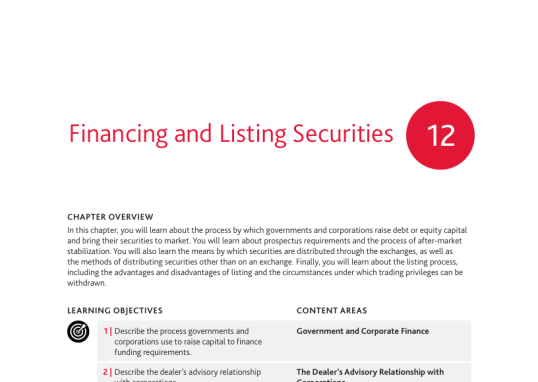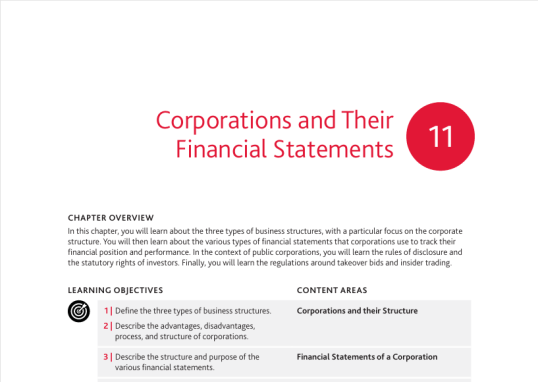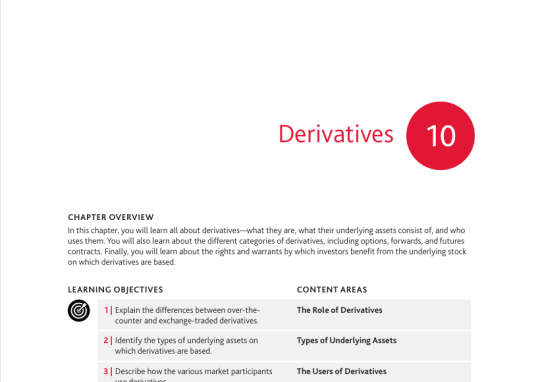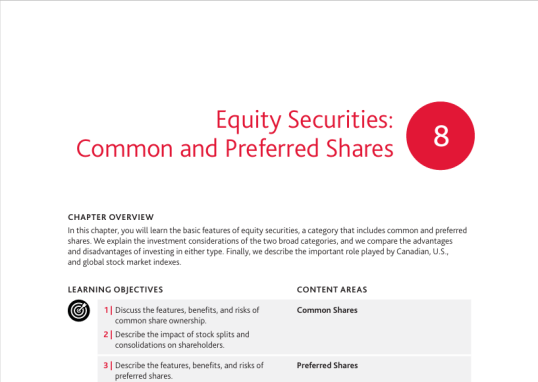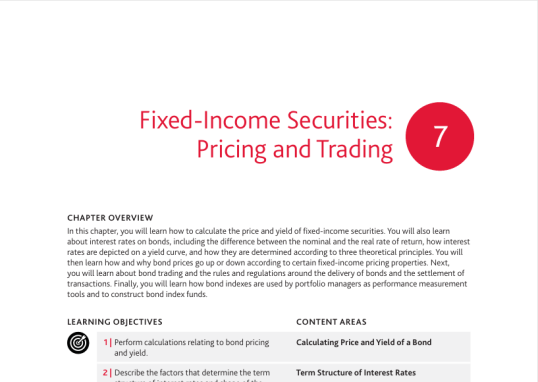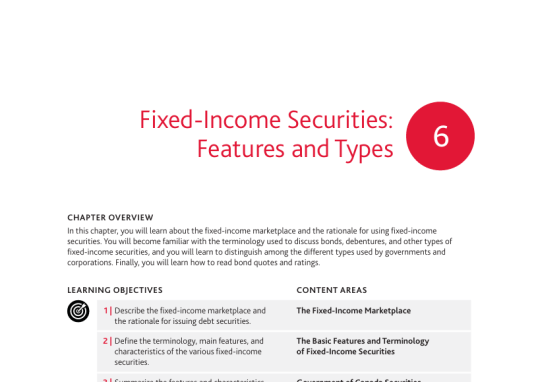CSC V.1 Chapter9 notes
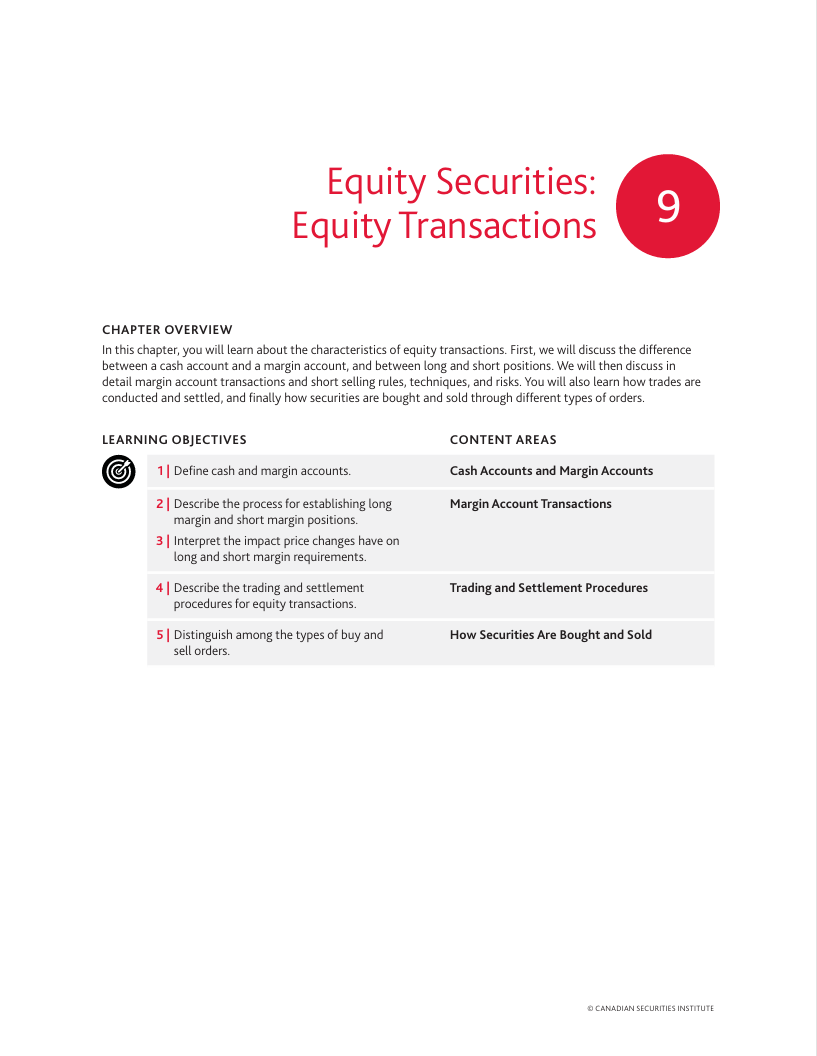
EQUITY SECURITIES: EQUITY TRANSACTIONS
CASH ACCOUNTS
- Under cash account rules, an investor must fully pay for purchases and delivery of securities by no later than the settlement day of the trade. For equity securities, this is two business days after the trade date
- Free credit balances are uninvested funds held in client accounts. These are payable on demand to clients; however may be used in the “conduct” of the member firm’s business. What this means is that free credit balances count towards the investment dealer’s capital base for regulatory purposes
- A long position represents actual ownership in a security
- A short position is created when an investor sells a security that the investor does not own
MARGIN ACCOUNTS
- Margin refers to the portion of funds the investor must personally provide for a purchase. The remaining amount is the loan value that the investment dealer will provide to the client
- Investment dealers loan money to investors because this generates more trading activity (higher commissions) and because loaned money is charged interest. Because these are secured loans – secured by the stocks being purchased – they tend to be very safe loans
- A long margin position allows an investor to partially finance the purchase of securities by borrowing money from the dealer
- A short margin position allows an investor to sell securities short by arranging for the dealer to borrow the securities to cover the short position
- A Margin Account Agreement Form must be obtained from a potential margin client before business is transacted
- Interest on the loan is calculated daily and charged monthly
LONG MARGIN ACCOUNTS
- The IIROC establishes Maximum Loan Values – member firms may loan less at their discretion, but not more. The loan value is based on the market price of the security and is constantly re-adjusted as the market price of the security changes
- Loan values (For information purposes only):
- $2.00 and over – 50% of market value
- $1.75 to $1.99 – 40% of market value
- $1.50 to $1.74 – 20% of market value
- Under $1.50 – No loan value
- Securities Eligible for Reduced Margin – 70% of market value
- There are five distinct steps that must be performed in order to calculate the margin required for an investor at any one time:
- Calculate total cost of the purchase
- Calculate the loan value, based on most current market close
- Calculate the margin: #1 – #2
- If the price changes, re-calculate the loan value
- Compare the original loan value to new loan value. If 4 is greater than #2, there is a margin surplus. If #2 is greater than #4, there is a margin deficit
LONG MARGIN EXAMPLES:
EXAMPLE: An investor purchases 2,000 shares at $1.70. What is the margin required? What is the margin surplus or deficit the next day, assuming the shares close at $1.82?
- Total cost of purchase: 2,000 x $1.70 = $3,400
- Loan value: 20% of $3,400 = $680
- Margin required: $3,400 – $680 = $2,720
- New loan value: 40% x $1.82 x 2,000 = $1,456
- Margin surplus: $1,456 – $680 = $776
EXAMPLE: An investor purchases 1,000 shares at $15, believing that the security was common stock (50% loan value). After making the appropriate margin deposit, she learns that it was eligible for reduced margin (option-eligible) the next day when it closes at $17.50. What is her margin surplus or deficit?
- Total cost of purchase: 1,000 x $15 = $15,000
- Original loan value: 50% of $15,000 = $7,500
- Margin required: $15,000 – $7,500 = $7,500
- New margin: 70% of 1,000 x $17.50 = $12,250
- Margin surplus: $12,250 – $7,500 = $4,750
MARGIN RISKS
- Margin increases market risk – margin leverages returns and losses
- Loan and interest must be repaid – this is regardless of the value of the security purchased
- Margin calls must be paid without delay – and this could result in losses\
SHORT SELLING
- Short selling is the sale of securities that the seller does not own. The motivation is to sell the securities today and buy in the future at a lower price. Short selling is done by Investor One borrowing the shares from Investor Two through the investment dealer
- Short selling – Simplified Steps
- Your client calls you and instructs you to sell 10,000 shares of ABC stock
- Your firm lends the ABC shares to your client
- The proceeds from the short sale are deposited in the client’s account
- The client deposits the required margin into the account
- The share price falls and you buy back the shaers and return them to the firm
Margining Short Positions
- Margining Short Positions (For information only):
- $2.00 and over – 150% of market value
- $1.50 to $1.99 – $3.00 per share
- $.25 to $1.49 – 200% of market value
- Under $.025 – 100% of market value plus $.25 per share
- Securities Eligible for Reduced Margin – 130% of market value
SHORT SELLING EXAMPLE
EXAMPLE: An investor short-sold 3,000 shares of DEF Security, eligible for reduced margin, at $22 per share and bought it back at $20. What is his margin requirement and profit/loss on the position?
Margin requirement:
Minimum account balance: 3,000 x $22 x 130% = $85,800
Less proceeds from short sale: 3,000 x $22 = $66,000
Minimum (additional) margin required: $19,800
Profit/loss:
Sale proceeds: 3,000 x $22 = $66,000
Buy-back: 3,000 x $20 = $60,000
Profit: $66,000 – $60,000 = $6,000
SHORT SELLING – MAJOR POINTS
- There is no time limit on short sales. Short positions can be maintained indefinitely, provided that the stock does not become de-listed or worthless, as long as the investor can borrow the shares, and adequate margin is maintained in the short account
- If the investment dealer cannot borrow shares, the investor may have to cover the position immediately, regardless of its prevailing market price
- All exchanges require that their members determine whether a sell order is a short or long sale, and total short positions are compiled and reported twice a month
DANGERS OF SHORT SELLING
- There are numerous dangers:
- Borrowing shares: There can be difficulties borrowing a sufficient quantity of the shorted stock
- Adequate margin: The short seller is responsible for maintaining adequate margin
- Liability: The short seller is liable for paying any dividends
- Buy-in requirements: Become effective if adequate margin cannot be maintained by the client
- Insufficient information: It is difficult to obtain up-to date information on total short sales of a security
- Price action: A shorted security may become volatile
- Unlimited risk: Short selling exposes the investor to a theoretically unlimited loss
- Regulatory risk: There is the risk that regulators may ban short selling for certain types of stocks
SETTLEMENT PROCEDURES
- Once a transaction has occurred, both buyer and seller receive a confirmation and they must “settle” the
transaction. The seller must deliver the security and the buyer must deliver the money - In Canada, stock and bond certificates are not in the form of paper but held electronically by a clearing corporation. At the end of the day, the clearing corporation settles all purchase and sales of stock and bonds among dealers
HOW SECURITIES ARE BOUGHT AND SOLD
- Order types are generally categorized according to the following characteristics:
- Duration – How long is the order valid for?
- Price restrictions – Have any limits been set on the price?
- Special instructions – Are there any special conditions attached to the order?
- Other – For example, are there any changes to the original order
- The difference between the bid and the ask is known as the bid-ask spread
TYPES OF ORDERS
- Market Order – assures immediate execution, gives the trader the authorization to buy at the offer price and sell at the bid price
- Limit Order – implies a price limit on the order, establishing a maximum buy price and minimum sell price
- Day Order – stipulates that the limit order entered will be in force for only one day, then automatically cancels. All orders are considered day orders unless otherwise specified
- Good Through Order – stipulates a finite number of days that the limit order is open for. It automatically cancels if not filled
- On-Stop Sell Order – (also known as stop loss order) a sell order that is executed when the price drops to a
specified level, at which point it becomes a market order. This is a protective strategy to lock in gains or limit losses when an investor is long a security - On-Stop Buy Order – (also known as a stop buy order) that is executed when the price rises above a specified level, at which point it becomes a market order. This is the opposite of a stop-loss order and is often used by short-sellers to protect from large losses
- Professional (Pro) order – a Pro Order relates to an account belonging to an employee, partner, director, officer, etc. of the member firm. “Where the order of a client competes with a non-client order at the same price, the client’s order is given priority of execution over the non-client order.”
Author
shanghaizhangyijie@gmail.com
